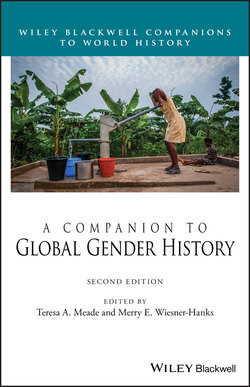Читать книгу A Companion to Global Gender History - Группа авторов - Страница 34
The Terrain and What is at Stake
ОглавлениеRitual and myth are central to the construction of identity, in particular gendered identity, in most if not all social and historical contexts. Although often cloaked as traditional, unchanging and unchanged, this is decidedly not the case, as ritual and myth are subject to the same vicissitudes of time and place as the system of belief and practice with which they are associated or in which they occur (Bell, 1992: 118–24). Instead, we might better engage ritual and myth as media that invent, shore‐up, and/or challenge the why, who, how, and what of being human in the world. As discursive practices, ritual and myth relate and reaffirm gender ideologies and their performances as “dense transfer point[s] for relations of power” (Foucault, 1978). Different kinds of myth circulate through social bodies, including cosmogonic myths that center on the creation of a world, demogonic myths that center on the creation of social bodies, and anthropogonic myths that center on the creation of human animals. All these kinds of myths are central to the formation and structuring of human social systems.
Gender is an aspect of identity that is represented, under the sway of Euro‐Western gender ideological systems, as all encompassing. The bodily locating and locking of gender is enacted through the making, and then the marking, of genitals. Once created, the genitals are that by which we know ourselves and that by which we are dominated (Fausto‐Sterling, 2012). In the scientific narrative of gender ideology, this domination is achieved through chemical and cognitive processes, the latter of which are said to appear properly at the time of human pubescence (Schiebinger, 2004; Tuana, 2004; Martin, 1992). The fleshy bits named genitals, both the origin and target site of these processes, are seen to be of two kinds only, and these two kinds are taken to be opposites in all ways: that is bodily, socially, and cognitively (Laqueur, 1992). Opposite is taken to mean that something is completely and utterly different from another thing; as night is to day, the earth to the sky, yin to yang, and the moon to the sun. Opposition is a construct, and not a natural fact coming to meaning within a context. There are other sources besides science for this kind of thinking, such as the ancient Greeks, whose oppositional thinking directly influenced Christianity, Judaism, and Islam through the texts attributed to such philosophers as Plato and Aristotle and the physicians Hippocrates and Galen, among others.
Operating in an oppositional framework means that the notion of opposition dominates how any subject is thought. Also, an oppositional framework insists that two opposites cannot and do not share of each other. And finally, the framework imbues one of the opposites with positive value and the other with negative value. For example, in many masculine hegemonies, the female, girls/women, and the feminine carry negative value (–) and male, boys/men, and the masculine carry positive value (+). Equally, gender ideologies framed within and by opposition, construct and enforce their own versions of heteronormativity (Butler, 2004: 79–80). As the majority of gender ideologies around the globe have been impinged upon by Euro‐Western colonialism, they evince in lesser or greater degrees the framework of opposition.
For example, as a concept, reproduction is equally shaped by oppositional thinking so only two are imagined as part of the process of reproduction rather than one or more than two. We know, however, that reproduction takes multiple forms and can involve only one actor or multiple actors and yet we persist with imagining only dyads.1
The naturalization and mystification of gendering is called gender ideology. Drawing on the Althusserian‐Marxian understanding of ideology, ideology is the outcome and process of mystifying social relations so that these relations appear as if they are naturally–biologically and/or psychically–metaphysically determined. When gendering is mystified, its creation is turned over to nature and/or deity so that nature (often called Mother Nature and then paired with a masculine deity) and/or deity(ies) are given credit for “making gender,” while deity is further represented as requiring the surveillance of proper gender, sexuality, and reproduction. The turning over of gender to nature and/or deity(ies) obfuscates the power relations that infuse and demarcate our social relations.
